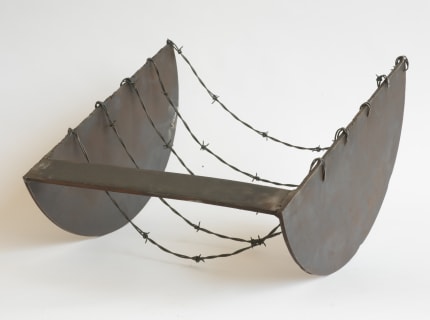Melvin Edwards: Painted Sculpture
Alexander Gray Associates presented its fifth exhibition of work by Melvin Edwards (b.1937), Painted Sculpture. An influential figure in African American art, Edwards’ practice reflects his engagement with the history of race, labor, and violence, as well as with themes of the African Diaspora. The Gallery’s exhibition features historical painted sculpture and works on paper—many of which have not been exhibited for decades. Extending Edwards’ extraordinary range as a sculptor, the presentation highlights the artist’s commitment to formal innovation.
Edwards created his first painted sculptures in 1968 during a summer residency in Minneapolis, MN. After he left the city, under the aegis of the celebrated museum director Martin Friedman, these chromatic works comprised one of the Walker Art Center’s first solo outdoor sculpture exhibitions. Later that same year, Edwards joined the Smokehouse Associates in New York, which was founded by fellow artist and friend William T. Williams. Together with other members of the collective, he painted vivid, abstract murals in Harlem, transforming vacant sites in an effort to revitalize the neighborhood.
Adapting the color and geometry of these projects, Edwards’ primarily monochromatic painted sculptures harness the potential of paint to establish relationships between disparate elements while introducing the unexpected. These large-scale works are in multiple museum collections, including Crystal Bridges Museum of American Art, Bentonville, AR; the Herbert F. Johnson Museum of Art, Cornell University, Ithaca, NY; and the Wadsworth Atheneum Museum of Art, Hartford, CT, as well as on display outside Bethune Tower in Harlem, NY.
Edwards’ approach to color is instinctual. “It is so hard to explain the meaning of the color/form relationship,” he explains. “Once my intuitive sense is in gear I tend to see the possibilities of some color relationships and their implications.” Meanwhile, his works’ forms expand on the modernist vocabulary of Alexander Calder’s stabiles while inviting comparisons to Julio González, David Smith, and Mark di Suvero’s steel constructions.
Characterized by an inherent dynamism, Edwards’ painted sculptures are calligraphic—their linear quality recalling the artist’s interest in capitalizing on the potential of sculpture to function as, in his words, “drawing in space.” Works like Felton (1974), a homage to the artist’s grandfather, James Felton, and Mozambique (c.1974), titled in tribute to the East African nation, reflect this interest in the graphic. Juxtaposing static structures with curved and swooping shapes, Edwards characterizes these pieces as giving the impression of “motion captured and frozen."
At the same time, by combining autobiography with formalist concerns, Felton, Mozambique, and other painted sculptures imbue abstraction with complex histories and sociopolitical issues—recalling the artist’s 1971 assertion that Black artists “must make works that use our lives and feelings as their basis for existence.” At once resolutely abstract yet deeply personal, these lyrical, chromatic structures reveal Edwards’ belief in the power of abstraction to alter spaces and transform viewers.


